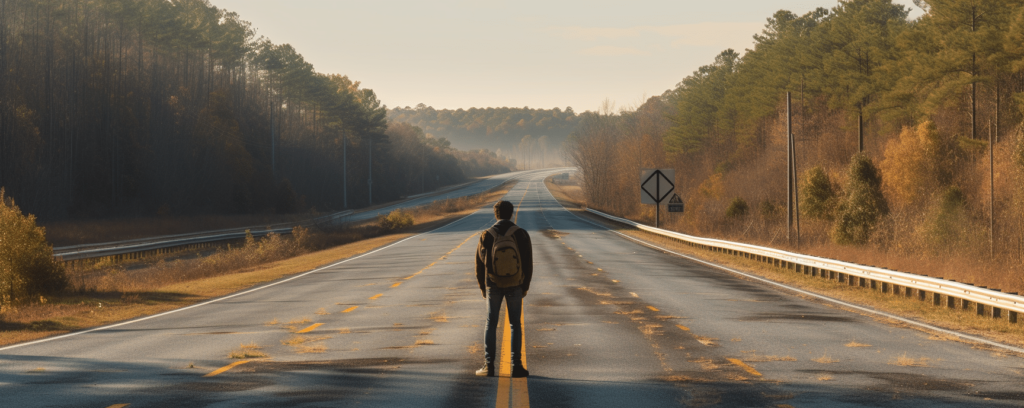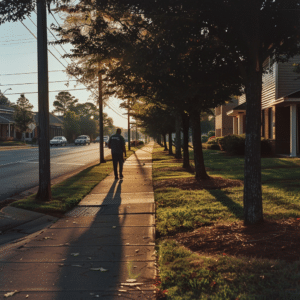Is It Illegal to Walk on the Highway? Roadway Walking Laws
Last updated Wednesday, April 17th, 2024

If you’re wondering, ‘Is it illegal to walk on the highway?’ the answer is typically yes. Highways are designed for fast-moving vehicles, and pedestrian access is often prohibited to ensure safety. However, specific situations and locations may have exceptions to this rule. This article provides an in-depth look at the risks, laws, and exceptions surrounding pedestrian highway access.
Key Takeaways
- Pedestrians are generally prohibited from walking on highways due to the high speeds of vehicles, limited reaction times for drivers, and increased risk of serious injuries or fatalities.
- While pedestrians have the right of way in crosswalks and intersections, they must use sidewalks where available and should always obey traffic signals and signs to ensure safety.
- In the event of a pedestrian accident on a highway, collecting evidence and seeking legal advice promptly is crucial for pursuing compensation for any injuries or damages incurred.
Get Your FREE Case Review Today
Contact us today and we will help you get the compensation that you deserve.
or Send Us Your Case DetailsGet Your FREE Case Review Today
Contact us today and we will help you get the compensation that you deserve.
or Send Us Your Case DetailsThe Basic Rule: Highways and Pedestrians Don’t Mix
Pedestrian traffic and highways, as a rule of thumb, are a dangerous combination. Highways are designed for vehicles traveling at high speeds, and the presence of pedestrians can disrupt the traffic flow and significantly increase safety risks. The danger for pedestrians is enhanced due to the speed of vehicles and the limited time drivers have to react if a pedestrian is spotted on the highway.
Yet, like most laws, this one also carries exceptions. In certain situations, walking on the shoulder or the berm of the highway can be legal. These exceptions are generally applicable in rural or underdeveloped areas where other safer options for pedestrians might not exist.
Exceptions to the Rule
In regions that are rural or less developed, and thus lack sidewalks or pedestrian paths, the law permits pedestrians to walk on specific sections of the highway. This is not an ideal situation, but sometimes it becomes a necessity due to the absence of sidewalks or pedestrian paths.
However, these are exceptions and not the rule, highlighting the importance of safer pedestrian walking options.
Highway Hazards: Why Walking Is Often Illegal
The law often prohibits walking on highways due to the grave risks it poses for pedestrians. Highways are access-controlled roads, designed with the primary purpose of optimizing safety and maintaining traffic flow for high-speed vehicles. The risks for pedestrians are significantly amplified on such roadways owing to a variety of factors, including the high speeds of vehicles and potential for serious or even fatal accidents.
A prime example of the logic behind such prohibition is seen in the UK where roads designated as motorways prohibit pedestrian access due to factors like high vehicle speeds and the slipstream effect from large vehicles.
High Speeds and High Risks
The high velocity of vehicles on highways constitutes a serious threat to pedestrians, with the probability of deadly accidents escalating markedly as speed increases. The speed limit on highways is typically much higher than on local streets, leading to a significant speed differential between other vehicles and oncoming traffic, especially for pedestrians.
The statistics are alarming. As the speed of vehicles increases from 20 to 30 mph, the likelihood of a pedestrian fatality in a crash jumps from 5% to 45%. This probability further escalates to 85% when the vehicle speed reaches 40 mph. This data underscores the risks associated with high-speed vehicles sharing the same space with pedestrians.
Limited Visibility and Reaction Time
The dangers for pedestrians on highways are further amplified by limited visibility and a diminished window for reaction. The high speeds of vehicles may not allow drivers sufficient time to react and prevent collisions, especially if a pedestrian suddenly appears on the roadway. This risk is heightened during nighttime or low-light conditions when visibility is compromised.
The dangers are not just theoretical. In Florida, for instance, the majority of pedestrian fatalities occur during hours of darkness or low-light conditions, emphasizing the risks pedestrians face when visibility is compromised. Long stretches of highway that lack adequate lighting pose significant challenges for drivers in spotting and reacting to pedestrians, particularly during nighttime.
Understanding Right of Way and Pedestrian Laws
Besides grasping the risks of walking on highways, it’s equally pivotal to understand the laws regarding the right of way and pedestrian movement on highways and other roads. Statutes in many jurisdictions, such as Florida, require pedestrians to obey traffic control devices and signals at intersections to dictate their movement. This is done to ensure the safety of all road users, including drivers and pedestrians.
While pedestrians generally have the right of way at crosswalks, when crossing a roadway at a location other than a marked crosswalk or intersection, pedestrians must yield to vehicles and be mindful of other pedestrians. This law underscores the importance of crosswalks and intersections as designated safe zones for crossing the road.
Crosswalks and Intersections: Pedestrian Zones
Crosswalks and intersections, often found at cross streets, play a key role in ensuring pedestrian safety. They are designed as dedicated zones for pedestrians to cross roads. At these locations, drivers are obligated by law to yield to pedestrians, making them safer crossing points compared to other parts of the road.
However, pedestrians need to remember that they can’t cross intersections diagonally unless specifically authorized by pedestrian traffic signals or other traffic control devices. This restriction is in place to ensure clear and safe pedestrian paths that don’t interfere with the flow of vehicular traffic. Also, during the flashing ‘DON’T WALK’ signal phase, drivers see alternating flashing red lights indicating they must yield to pedestrians present in the crosswalk before proceeding.
Sidewalks and Pathways: Legal Walking Alternatives
Pedestrians are legally recommended to use sidewalks and pathways, which are deemed the safest places for walking. If sidewalks are available, pedestrians are legally required to use them rather than walking on the roadway. This not only ensures their safety but also helps maintain the smooth flow of vehicular traffic on the roadway as pedestrians walk on designated paths.
Consequences for Unlawful Pedestrian Presence on Highways
Illegal pedestrian presence on highways can result in legal repercussions, in addition to the clear safety dangers. Pedestrian access is typically restricted on highways to ensure the safety of both pedestrians and vehicle operators by limiting interactions on these high-speed roadways.
The rule prohibiting pedestrian access extends not only to the main lanes of highways but also to ramps leading to or from highways. There are exceptions to this prohibition, such as authorized maintenance personnel who may need to perform duties related to highway upkeep.
Pedestrian Safety Tips for Road Users

- Remain vigilant at all times
- Avoid distractions, such as using your phone or listening to music
- Follow traffic laws, including using crosswalks and obeying traffic signals
By following these tips, you can help ensure your safety while walking on highways.
When walking near roadways, pedestrians should:
- Not step into the street from between parked vehicles
- Yield to traffic if necessary to cross mid-block
- Be cautious of cars entering or exiting driveways and those reversing in parking lots
- Ensure to make eye contact with drivers when possible
Walk Facing Traffic
In the absence of sidewalks, pedestrians should walk on the shoulder facing traffic, in the opposite direction of traffic, and keep as much distance from vehicles as possible. This practice increases their visibility to oncoming drivers, enhancing their safety.
Walking on the left side of the road, relative to the pedestrian’s direction, is mandated because it allows pedestrians to better see oncoming vehicles. This in turn enables them to take evasive action if necessary, thereby enhancing their safety.
Be Visible and Alert
Being visible and alert constitute two key elements of pedestrian safety. Pedestrians can enhance their visibility to drivers by wearing bright clothing during the day and using reflective materials or a flashlight at night.
Alertness, on the other hand, involves reducing distractions such as headphones or mobile phones, particularly when crossing streets. Making eye contact with drivers can help pedestrians confirm that they have been seen, which is especially crucial while crossing roads.
What Drivers Should Know: Sharing the Road with Pedestrians
All drivers bear the responsibility of sharing the road with pedestrians. Drivers and pedestrians both have a role to play in ensuring safety on the road. Drivers must maintain vigilance at all times to prevent accidents when sharing the road with pedestrians.
This heightened awareness is particularly important in uncommon pedestrian areas like highways where drivers may not expect foot traffic. Adhering to traffic laws and signals is crucial for both pedestrians and drivers to coexist safely, even in areas where walking is less common.
Yielding to Pedestrians
Drivers have a legal obligation to yield to pedestrians at crosswalks and intersections. This means that drivers must stop for pedestrians at crosswalks with traffic control signals when the pedestrian has a permitted signal to cross. Even when traffic control signals are not in place or in operation, vehicles must yield to pedestrians crossing within a crosswalk.
These laws emphasize the necessity of prioritizing pedestrian safety in all traffic situations.
When Pedestrians Must Use Highways: Alternative Routes and Detours
Under certain conditions, like in rural or undeveloped regions, highways may occasionally be the only feasible means for pedestrians to move between locations. However, pedestrians should always seek out possible alternative routes, such as local streets or pedestrian pathways, before considering walking along or crossing highways.
When planning their journey, pedestrians should:
- Identify any potential detours that can serve as a safer option compared to walking on the highway
- Be aware of the safest ways to proceed if detours necessitate highway use, such as following any temporary walkways or signage specifically set up to guide them
- Remain vigilant for traffic and stay as far away from moving vehicles as possible
- Make use of reflective clothing or lights during low visibility conditions
Planning Your Path
Advance route planning can assist pedestrians in bypassing highways and unsafe walking situations. Starting with paths you know well can be a safe strategy when planning your route to avoid highways. Reflecting on previous trips through an area can help in identifying safe routes and avoiding highways.
In today’s digital age, technology like GPS navigation or mapping apps can also be utilized to guide your routes in areas where the safety of pedestrian paths may be unclear. These tools can provide accurate and updated information about the safest and quickest routes, helping pedestrians avoid the dangers associated with walking on highways.
Legal Recourse After a Pedestrian Accident on a Highway
Accidents involving pedestrians on highways can have catastrophic outcomes, potentially causing pedestrian injuries or even death. In such instances, pedestrians should consider pursuing compensation for any injuries or damages sustained.
It’s crucial for a pedestrian involved in an accident to collect the driver’s contact and insurance information to support their compensation claim. Contacting a car accident lawyer promptly after an accident is vital to protect a pedestrian’s legal rights and to ensure they can make a claim for insurance coverage or file a lawsuit for damages.
Collecting Evidence
Gathering evidence forms a vital part of constructing a legal case for compensation following a pedestrian accident on a highway. This could involve taking photographs of the accident scene, the vehicle involved, and any visible injuries.
Preserving the condition of clothing and personal items as they were right after the accident can be helpful evidence for showing the impact. Writing a detailed account of the incident as soon as possible ensures the accuracy of memory and consolidates information in one place, which can be crucial during legal proceedings.
Pursuing Compensation
Post a pedestrian accident on a highway, it’s essential to initiate the claims procedure swiftly by notifying insurance companies about the incident. However, pedestrians should proceed with caution when discussing fault or signing any documents without legal advice.
An experienced injury attorney can provide necessary guidance in preserving evidence, negotiating with insurance companies, and liaising with the police officer to ensure just compensation. Cars are expected to exercise a heightened duty to avoid pedestrians and may be held at fault even when the pedestrian was not following the law, such as in cases of jaywalking. In this process, dealing with the insurance company involved is crucial for a successful outcome.
Frequently Asked Questions
Can you walk next to an interstate?
No, it’s illegal to walk next to an interstate. You could be ticketed.
Are you allowed to walk on a road?
Yes, you are allowed to walk on a road if there is no sidewalk, but you must walk facing traffic and obey signs and signals. Always keep as much distance from traffic as possible.
What are some hazards for pedestrians on highways?
Pedestrians on highways face hazards such as high vehicle speeds and limited visibility, increasing the likelihood of fatal accidents and reducing reaction time for both drivers and pedestrians. Be cautious when walking near or crossing highways.






